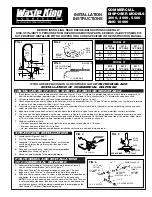
While a certain amount of moisture in the soil is
necessary, excessive moisture may cause soil particles
to stick together and prevent good compaction. If
soil is extremely wet, allow it to dry somewhat before
compacting.
If soil is so dry as to create dust clouds while operating
plate, some moisture should be added to the ground
material to improve compacting. This will also reduce
service to the air filter.
IDLE SPEED
Set the throttle control lever to the SlOW position to reduce
stress on the engine when compacting is not being performed.
Lowering the engine speed will help extend the life of the engine,
as well as conserve fuel and reduce noise level.
STOP ENGINE
To stop the engine in an emergency, simply turn the engine switch
to the OFF position. Under normal conditions, use the following
procedure:
1. Move the throttle lever to the SlOW (
) position.
2. let the engine idle for one or two minutes.
3. Turn the engine switch to the OFF position.
Do not move the choke control to CLOSE to stop the
engine. Backfire or engine damage may occur.
Do not disengage the belt drive with the machine
running. This will cause friction and vibration on the
belt drive.
Sudden stopping at a high speed under a heavy load
is not recommended. Engine damage may result.
Rapid retraction of the starter cord (kickback) will pull
your hand and arm toward the engine faster than you
can let go. Broken bones, fractures, bruises, or sprains
could result.
Do not operate plate on concrete or on extremely
hard, dry, compacted surfaces. The plate will jump
rather than vibrate and could damage both plate and
engine.
4. Pull the recoil starter until engine compression has become
difficult to pull. Let the recoil return to the home position,
then pull quickly to start the engine. Repeat steps as needed.
Fully open the choke and set the throttle to the FAST position,
before operating the unit.
1. After engine warms up, pull throttle lever to accelerate engine
speed. Plate will begin vibrating and move forward.
2. The plate compactor is designed to run at an engine speed
(engine take off shaft) of 3600 rpm (normally considered
full throttle). Running the engine at lower rpm will result in a
decrease of compaction force and lower travel speed. It will
create excessive “out-of-sync” vibrations resulting in poor
compaction, maneuverability, excessive wear to the machine,
and discomfort to the operator.
3. In operation, guide the machine, but let the compactor do the
work. bearing down on the handle is unnecessary and causes
shock absorber wear.
4. On level surfaces the compactor moves forward rapidly. On
uneven surfaces or inclines, light forward pressure on handle
may be required to assist the compactor in moving forward.
5. The number of passes required to reach a desired compaction
level will depend on the soil type and on the soil’s moisture
content. Maximum soil compaction has been reached when
excessive kickback is noticed.
When using plate on paving stones, attach a pad
to the bottom of the plate to prevent chipping or
grinding surface of the stones. A special urethane pad
designed for this purpose is available as an optional
accessory.
OPERATING
13
|
Operation
29140US25M100.indd 13
2017/3/20 13:50:25






























